remote start Ram 2500 2020 User Guide
[x] Cancel search | Manufacturer: RAM, Model Year: 2020, Model line: 2500, Model: Ram 2500 2020Pages: 553, PDF Size: 21.99 MB
Page 37 of 553
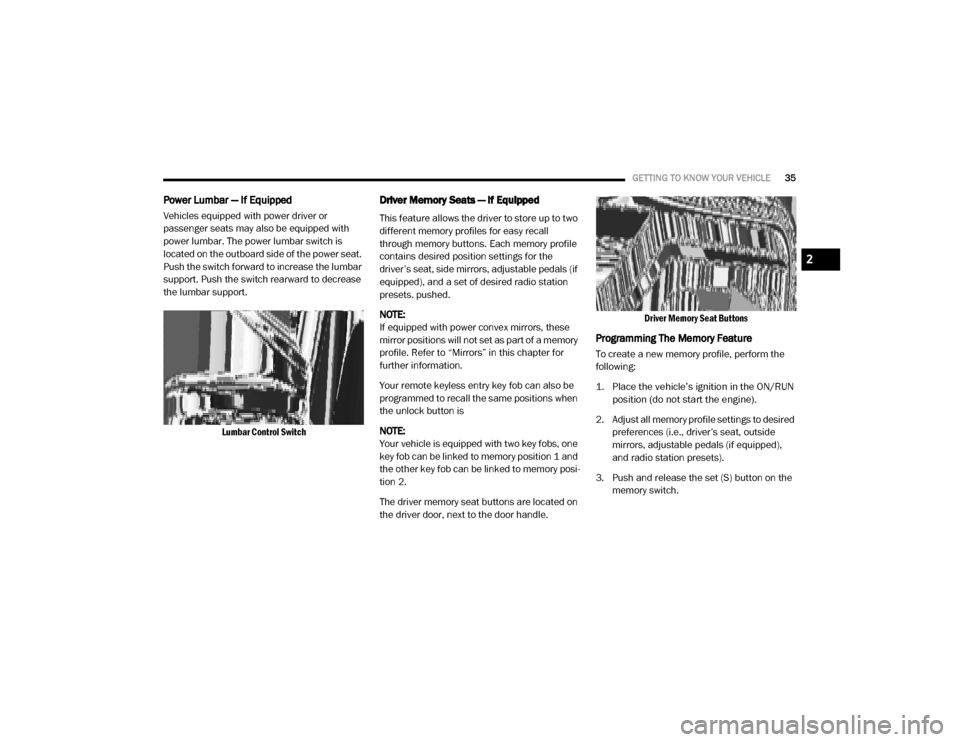
GETTING TO KNOW YOUR VEHICLE35
Power Lumbar — If Equipped
Vehicles equipped with power driver or
passenger seats may also be equipped with
power lumbar. The power lumbar switch is
located on the outboard side of the power seat.
Push the switch forward to increase the lumbar
support. Push the switch rearward to decrease
the lumbar support.
Lumbar Control Switch
Driver Memory Seats — If Equipped
This feature allows the driver to store up to two
different memory profiles for easy recall
through memory buttons. Each memory profile
contains desired position settings for the
driver’s seat, side mirrors, adjustable pedals (if
equipped), and a set of desired radio station
presets. pushed.
NOTE:
If equipped with power convex mirrors, these
mirror positions will not set as part of a memory
profile. Refer to “Mirrors” in this chapter for
further information.
Your remote keyless entry key fob can also be
programmed to recall the same positions when
the unlock button is
NOTE:
Your vehicle is equipped with two key fobs, one
key fob can be linked to memory position 1 and
the other key fob can be linked to memory posi -
tion 2.
The driver memory seat buttons are located on
the driver door, next to the door handle.
Driver Memory Seat Buttons
Programming The Memory Feature
To create a new memory profile, perform the
following:
1. Place the vehicle’s ignition in the ON/RUN
position (do not start the engine).
2. Adjust all memory profile settings to desired preferences (i.e., driver’s seat, outside
mirrors, adjustable pedals (if equipped),
and radio station presets).
3. Push and release the set (S) button on the memory switch.
2
20_DJD2_OM_EN_USC_t.book Page 35
Page 40 of 553
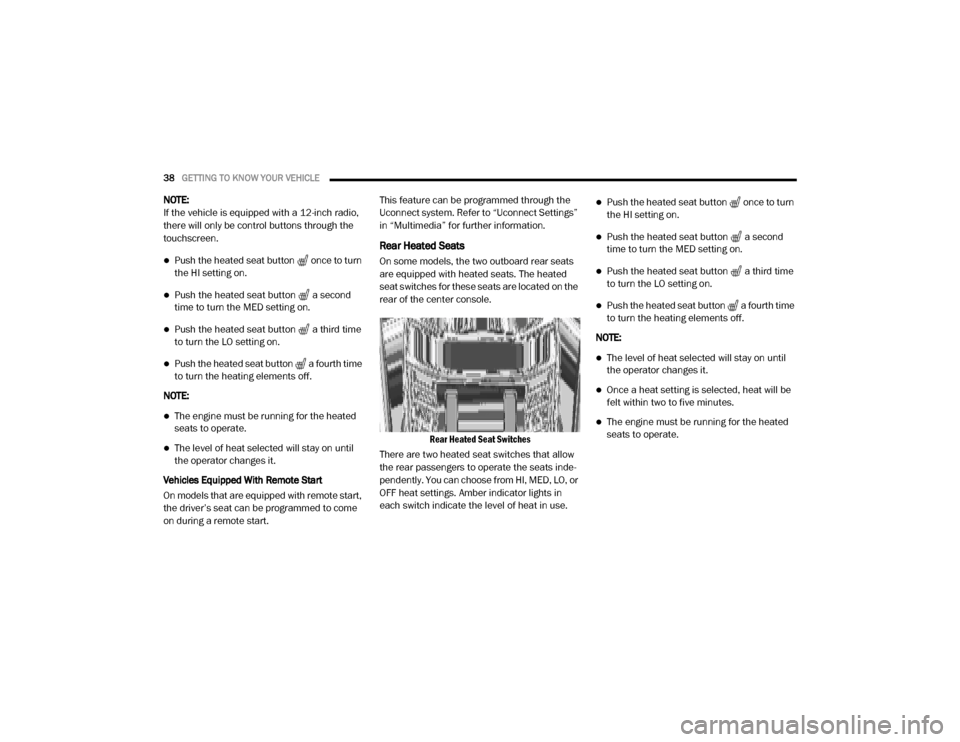
38GETTING TO KNOW YOUR VEHICLE
NOTE:
If the vehicle is equipped with a 12-inch radio,
there will only be control buttons through the
touchscreen.
Push the heated seat button once to turn
the HI setting on.
Push the heated seat button a second
time to turn the MED setting on.
Push the heated seat button a third time
to turn the LO setting on.
Push the heated seat button a fourth time
to turn the heating elements off.
NOTE:
The engine must be running for the heated
seats to operate.
The level of heat selected will stay on until
the operator changes it.
Vehicles Equipped With Remote Start
On models that are equipped with remote start,
the driver’s seat can be programmed to come
on during a remote start. This feature can be programmed through the
Uconnect system. Refer to “Uconnect Settings”
in “Multimedia” for further information.
Rear Heated Seats
On some models, the two outboard rear seats
are equipped with heated seats. The heated
seat switches for these seats are located on the
rear of the center console.
Rear Heated Seat Switches
There are two heated seat switches that allow
the rear passengers to operate the seats inde -
pendently. You can choose from HI, MED, LO, or
OFF heat settings. Amber indicator lights in
each switch indicate the level of heat in use.
Push the heated seat button once to turn
the HI setting on.
Push the heated seat button a second
time to turn the MED setting on.
Push the heated seat button a third time
to turn the LO setting on.
Push the heated seat button a fourth time
to turn the heating elements off.
NOTE:
The level of heat selected will stay on until
the operator changes it.
Once a heat setting is selected, heat will be
felt within two to five minutes.
The engine must be running for the heated
seats to operate.
20_DJD2_OM_EN_USC_t.book Page 38
Page 41 of 553
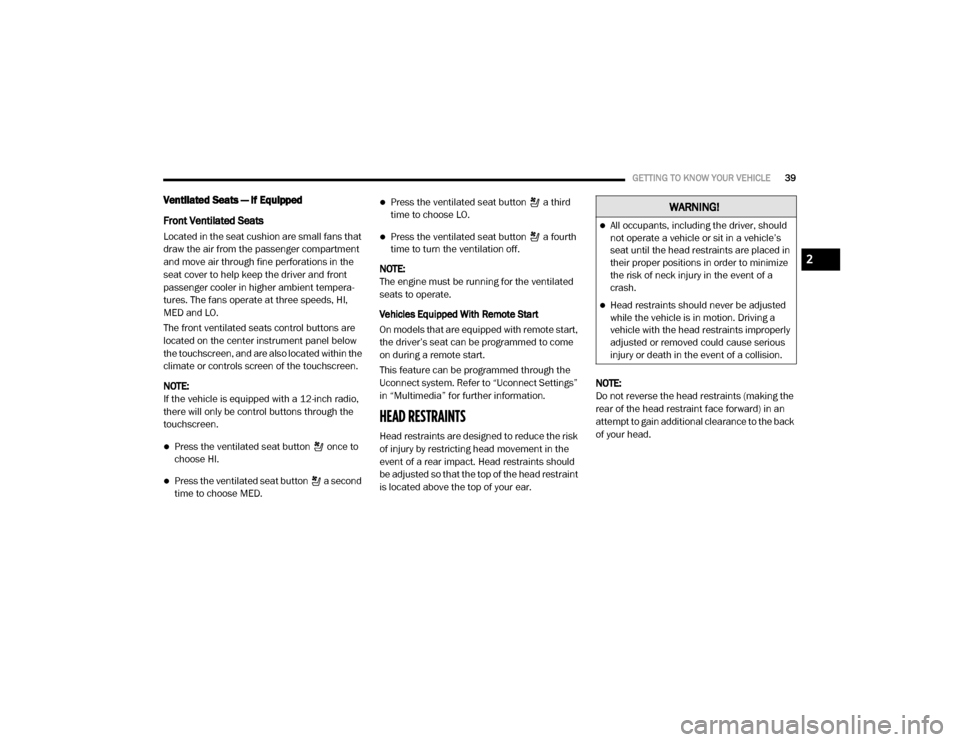
GETTING TO KNOW YOUR VEHICLE39
Ventilated Seats — If Equipped
Front Ventilated Seats
Located in the seat cushion are small fans that
draw the air from the passenger compartment
and move air through fine perforations in the
seat cover to help keep the driver and front
passenger cooler in higher ambient tempera -
tures. The fans operate at three speeds, HI,
MED and LO.
The front ventilated seats control buttons are
located on the center instrument panel below
the touchscreen, and are also located within the
climate or controls screen of the touchscreen.
NOTE:
If the vehicle is equipped with a 12-inch radio,
there will only be control buttons through the
touchscreen.
Press the ventilated seat button once to
choose HI.
Press the ventilated seat button a second
time to choose MED.
Press the ventilated seat button a third
time to choose LO.
Press the ventilated seat button a fourth
time to turn the ventilation off.
NOTE:
The engine must be running for the ventilated
seats to operate.
Vehicles Equipped With Remote Start
On models that are equipped with remote start,
the driver’s seat can be programmed to come
on during a remote start.
This feature can be programmed through the
Uconnect system. Refer to “Uconnect Settings”
in “Multimedia” for further information.
HEAD RESTRAINTS
Head restraints are designed to reduce the risk
of injury by restricting head movement in the
event of a rear impact. Head restraints should
be adjusted so that the top of the head restraint
is located above the top of your ear. NOTE:
Do not reverse the head restraints (making the
rear of the head restraint face forward) in an
attempt to gain additional clearance to the back
of your head.
WARNING!
All occupants, including the driver, should
not operate a vehicle or sit in a vehicle’s
seat until the head restraints are placed in
their proper positions in order to minimize
the risk of neck injury in the event of a
crash.
Head restraints should never be adjusted
while the vehicle is in motion. Driving a
vehicle with the head restraints improperly
adjusted or removed could cause serious
injury or death in the event of a collision.
2
20_DJD2_OM_EN_USC_t.book Page 39
Page 44 of 553
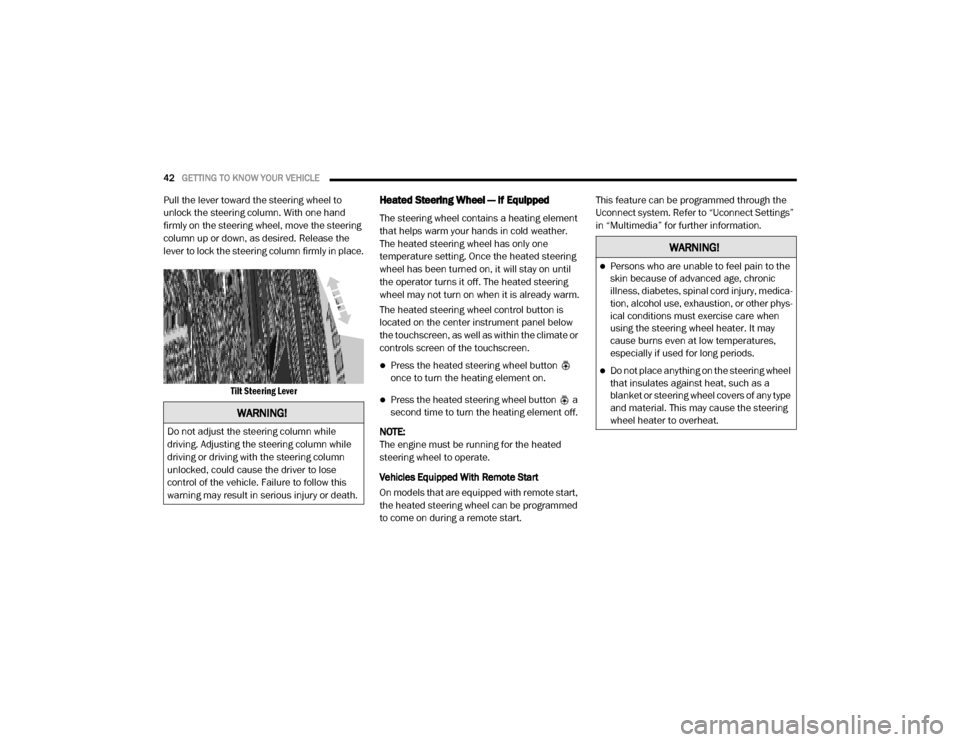
42GETTING TO KNOW YOUR VEHICLE
Pull the lever toward the steering wheel to
unlock the steering column. With one hand
firmly on the steering wheel, move the steering
column up or down, as desired. Release the
lever to lock the steering column firmly in place.
Tilt Steering Lever
Heated Steering Wheel — If Equipped
The steering wheel contains a heating element
that helps warm your hands in cold weather.
The heated steering wheel has only one
temperature setting. Once the heated steering
wheel has been turned on, it will stay on until
the operator turns it off. The heated steering
wheel may not turn on when it is already warm.
The heated steering wheel control button is
located on the center instrument panel below
the touchscreen, as well as within the climate or
controls screen of the touchscreen.
Press the heated steering wheel button
once to turn the heating element on.
Press the heated steering wheel button a
second time to turn the heating element off.
NOTE:
The engine must be running for the heated
steering wheel to operate.
Vehicles Equipped With Remote Start
On models that are equipped with remote start,
the heated steering wheel can be programmed
to come on during a remote start. This feature can be programmed through the
Uconnect system. Refer to “Uconnect Settings”
in “Multimedia” for further information.
WARNING!
Do not adjust the steering column while
driving. Adjusting the steering column while
driving or driving with the steering column
unlocked, could cause the driver to lose
control of the vehicle. Failure to follow this
warning may result in serious injury or death.
WARNING!
Persons who are unable to feel pain to the
skin because of advanced age, chronic
illness, diabetes, spinal cord injury, medica
-
tion, alcohol use, exhaustion, or other phys -
ical conditions must exercise care when
using the steering wheel heater. It may
cause burns even at low temperatures,
especially if used for long periods.
Do not place anything on the steering wheel
that insulates against heat, such as a
blanket or steering wheel covers of any type
and material. This may cause the steering
wheel heater to overheat.
20_DJD2_OM_EN_USC_t.book Page 42
Page 59 of 553
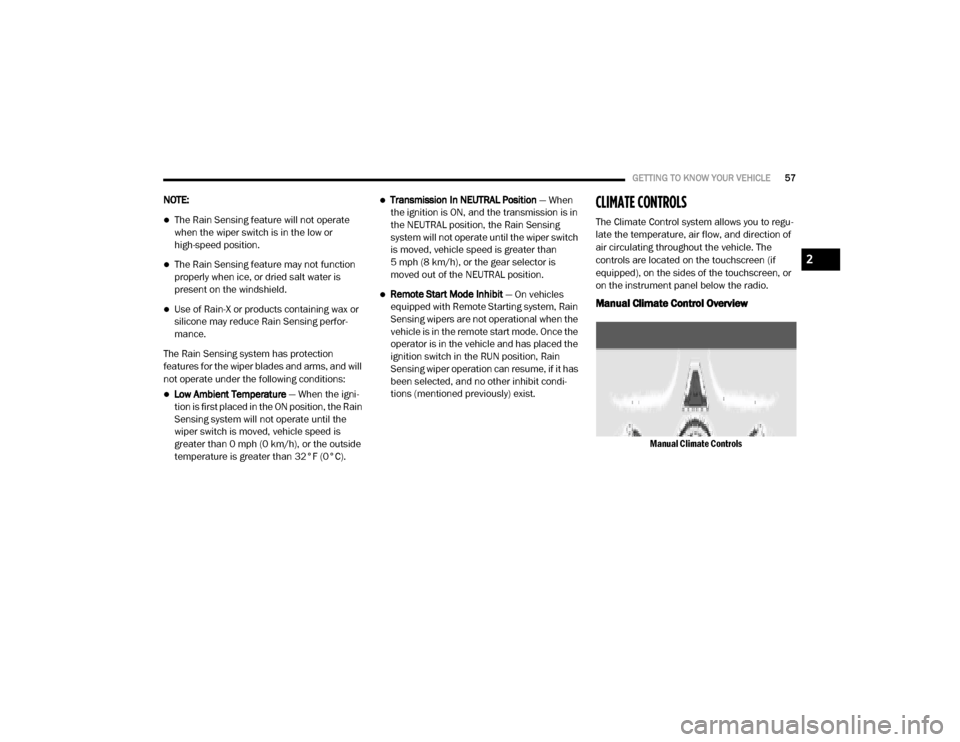
GETTING TO KNOW YOUR VEHICLE57
NOTE:
The Rain Sensing feature will not operate
when the wiper switch is in the low or
high-speed position.
The Rain Sensing feature may not function
properly when ice, or dried salt water is
present on the windshield.
Use of Rain-X or products containing wax or
silicone may reduce Rain Sensing perfor -
mance.
The Rain Sensing system has protection
features for the wiper blades and arms, and will
not operate under the following conditions:
Low Ambient Temperature — When the igni-
tion is first placed in the ON position, the Rain
Sensing system will not operate until the
wiper switch is moved, vehicle speed is
greater than 0 mph (0 km/h), or the outside
temperature is greater than 32°F (0°C).
Transmission In NEUTRAL Position — When
the ignition is ON, and the transmission is in
the NEUTRAL position, the Rain Sensing
system will not operate until the wiper switch
is moved, vehicle speed is greater than
5 mph (8 km/h), or the gear selector is
moved out of the NEUTRAL position.
Remote Start Mode Inhibit — On vehicles
equipped with Remote Starting system, Rain
Sensing wipers are not operational when the
vehicle is in the remote start mode. Once the
operator is in the vehicle and has placed the
ignition switch in the RUN position, Rain
Sensing wiper operation can resume, if it has
been selected, and no other inhibit condi -
tions (mentioned previously) exist.
CLIMATE CONTROLS
The Climate Control system allows you to regu -
late the temperature, air flow, and direction of
air circulating throughout the vehicle. The
controls are located on the touchscreen (if
equipped), on the sides of the touchscreen, or
on the instrument panel below the radio.
Manual Climate Control Overview
Manual Climate Controls
2
20_DJD2_OM_EN_USC_t.book Page 57
Page 214 of 553

212STARTING AND OPERATING
This feature allows the driver to operate the igni -
tion switch with the push of a button, as long as
the Remote Start/Keyless Enter-N-Go key fob is
in the passenger compartment.
Normal Starting Using ENGINE START/STOP
Button
To Turn On The Engine Using The ENGINE
START/STOP Button
1. The transmission must be in PARK.
2. Press and hold the brake pedal while pushing the ENGINE START/STOP button
once.
3. The system takes over and attempts to start the vehicle. If the vehicle fails to start, the
starter will disengage automatically after 10
seconds.
4. If you wish to stop the cranking of the engine prior to the engine starting, push the
ENGINE START/STOP button again.
NOTE:
Normal starting of either a cold or a warm
engine is obtained without pumping or pressing
the accelerator pedal. To Turn Off The Engine Using ENGINE START/
STOP Button
1. Place the gear selector in PARK, then push
and release the ENGINE START/STOP
button.
2. The ignition will return to the OFF mode.
3. If the gear selector is not in PARK, the ENGINE START/STOP button must be held
for two seconds or three short pushes in a
row with the vehicle speed above 5 mph
(8 km/h) before the engine will shut off. The
ignition will remain in the ACC mode until
the gear selector is in PARK and the button
is pushed twice to the OFF mode.
4. If the gear selector is not in PARK and the ENGINE START/STOP button is pushed
once with the vehicle speed above 5 mph
(8 km/h), the instrument cluster will display
a “Vehicle Not In Park ” message and the
engine will remain running. Never leave a
vehicle out of the PARK position, or it could
roll.
NOTE:
If the gear selector is not in PARK, and the
ENGINE START/STOP button is pushed once with the vehicle speed below 5 mph (8 km/h),
the engine will shut off and the ignition will
remain in the ACC position. If vehicle speed
drops below 1.2 mph (1.9 km/h), the vehicle
may AutoPark. See AutoPark section for further
details.
ENGINE START/STOP Button Functions — With
Driver’s Foot OFF The Brake Pedal (In PARK Or
NEUTRAL Position)
The ENGINE START/STOP button operates
similar to an ignition switch. It has three modes:
OFF, ACC, and RUN. To change the ignition
modes without starting the vehicle and use the
accessories, follow these directions:
1. Start with the ignition in the OFF mode.
2. Push the ENGINE START/STOP button once to place the ignition to the ACC mode.
3. Push the ENGINE START/STOP button a second time to place the ignition to the RUN
mode.
4. Push the ENGINE START/STOP button a third time to return the ignition to the OFF
mode.
20_DJD2_OM_EN_USC_t.book Page 212
Page 218 of 553

216STARTING AND OPERATING
Tip Start Feature
Do not press the accelerator. Cycle the ignition
switch briefly to the START position and release
it. The starter motor will continue to run and will
automatically disengage when the engine is
running.
Keyless Enter-N-Go — Ignition
Keyless Push Button Ignition
This feature allows the driver to operate the igni -
tion switch with the push of a button, as long as
the Remote Start/Keyless Enter-N-Go key fob is
in the passenger compartment.
Normal Starting
Using The ENGINE START/STOP Button
1. The transmission must be in PARK or NEUTRAL.
2. Press and hold the brake pedal while pushing the ENGINE START/STOP button
once.
3. The system takes over and attempts to start the vehicle. If the vehicle fails to start, the
starter will disengage automatically after
25 seconds.
4. If you wish to stop the cranking of the engine prior to the engine starting, remove
your foot from the brake pedal and push the
ENGINE START/STOP button again.
NOTE:
Normal starting of either a cold or a warm
engine is obtained without pumping or
pressing the accelerator pedal.
Under cold weather conditions, the engine
may not immediately crank if the “Wait To
Start” telltale is illuminated. This is normal
operation. For vehicles equipped with Keyless Enter-N-Go, the vehicle will automat
-
ically crank when the “Wait To Start” time has
elapsed. See the section “Starting Procedure
Engine Manifold Air Temperature 0°F to
66°F (18°C to 19°C)” for more information.
To Turn Off The Engine Using ENGINE START/
STOP Button
1. Place the gear selector in PARK, then push and release the ENGINE START/STOP
button.
2. The ignition will return to the OFF mode.
3. If the gear selector is not in PARK and the ENGINE START/STOP button is pushed
once, the instrument cluster will display a
“Vehicle Not In Park” message and the
engine will remain running. Never leave a
vehicle out of the PARK position, or it could
roll.
4. If the gear selector is in NEUTRAL, and the vehicle speed below 5 mph (8 km/h),
pushing the ENGINE START/STOP button
once will turn the engine off. The ignition will
remain in the ACC mode.
20_DJD2_OM_EN_USC_t.book Page 216
Page 267 of 553

STARTING AND OPERATING265
not operate the winch without reading and
understanding the complete winch owner's
manual.
Tensioning The Winch Rope
The winch rope must be properly tensioned
before use. Follow the instructions below to
tension the rope:
1. Un-spool the rope leaving five wraps of
rope on the winch drum.
2. Attach the hook to a suitable anchor point.
3. Apply at least 1,000 lbs (454 kg) of tension to the rope while winding the rope. Always
use care to ensure the rope does not pile up
on one side of the drum and is neatly wound
onto the drum.
Low Voltage Interrupt
Your winch is equipped with a device that will
interrupt winch function if the vehicle charging
system voltage drops to a low level. The winch
will not power-in or out for 30 seconds if this
device is tripped. If the interrupt is tripped, the
vehicle should be operated at high idle for a few
minutes to allow the vehicle charging system to
recover before continuing to winch.
Understanding The Features Of Your Winch
Winch Components
1.
Motor:
The winch motor is powered by the
vehicle charging system.
2. Remote Socket: The remote socket (which
will be located on the bumper assembly)
allows the remote control to be attached to the control pack to allow the winch to func
-
tion.
3. Winch Drum With Integral Brake: The winch
drum allows the rope to be stored on the
winch and transmits force to the rope. The
winch is equipped with an integral brake
that will stop rotation of the winch drum if
the winch motor is stopped.
4. Synthetic Rope: The synthetic rope allows
the winch to be connected to an anchor to
provide a pulling force. This synthetic rope is
highly flexible, lightweight, and it floats.
5. Clutch Lever: The clutch lever allows the
winch drum to be disconnected from the
winch motor to allow the rope to be pulled
from the winch by hand.
6. Remote Control: The remote control
provides the interface between the winch
operator and the winch. The remote control
provides the ability to power the winch in,
out, and stop the winch. To operate the
winch, the toggle switch is pressed down to
power the winch in and up to power the
winch out. The winch will stop if the switch
is left in the neutral (center) position.
CAUTION!
Be certain the anchor will withstand the load
required to tension the winch rope.
CAUTION!
The winch rope must spool on the winch
drum in the direction indicated on the drum
rotation decal on the winch.
5
20_DJD2_OM_EN_USC_t.book Page 265
Page 269 of 553

STARTING AND OPERATING267
(Continued)
(Continued)
General Information
Practice using your winch before you get stuck.
Some key points to remember when using your
winch are:
Always take your time to assess the situation
and plan your pull carefully.
Always take your time when using a winch.
Use the right equipment for the situation.
Always wear leather gloves and do not allow
the synthetic rope to slip through your hands
when handling the rope.
Only the operator should handle the synthetic
rope and remote control.
Think safety at all times.
Vehicle Recovery Using The Winch
Always keep hands and clothing clear of the
synthetic rope, hook and fairlead opening
during operation and when spooling.
Never wrap synthetic rope back onto itself.
Always use a choker chain, wire choker
rope or tree trunk protector on the anchor.
Never attach a recovery strap to the winch
hook to increase the length of a pull.
Never attempt to tow a vehicle with the
recovery strap attached directly to the
winch hook.
Never use bungee or kinetic straps that
develop tremendous and potentially
dangerous amounts of force when
stretched.
Always disconnect the remote control when
not in use.
Never winch when there are less than 10
wraps of synthetic rope around the winch
drum.
WARNING!
(Continued)
Always pass remote control through a
window to avoid pinching lead in door,
when using remote inside a vehicle.
Never leave the remote control plugged
into the winch while free spooling, rigging or
sitting idle.
WARNING! (Continued)
CAUTION!
Always know your winch: Take the time to
fully read and understand the included
Installation and Operations Guide, and
Basic Guide to Winching Techniques, in
order to understand your winch and the
winching operation.
Always inspect winch installation and
synthetic rope condition before operating
the winch. Frayed, kinked or damaged rope
must be replaced immediately. Loose or
damaged winch installation must be
corrected immediately.
Always be sure any element which can
interfere with safe winching operations is
removed prior to initiating winching.
Always keep remote control lead clear of
the drum, synthetic rope and rigging.
Inspect for cracks, pinches, frayed rope, or
loose connections. Replace if damaged.
Be careful not to pull the winch rope collar
through the rollers. Watch and listen to
winch for proper snugness.
5
20_DJD2_OM_EN_USC_t.book Page 267
Page 271 of 553

STARTING AND OPERATING269
6. Secure to the anchor point. Once you have
established your anchor point, secure the
tree-trunk protector or choker-chain around
the object.
Tree Trunk Protector
NOTE:
How to choose an anchor point: A secure
anchor is critical to winching operations. An
anchor must be strong enough to hold while
winching. Natural anchors include trees,
stumps and rocks. Hook the cable as low as
possible. If no natural anchors are available
when recovering another vehicle, your vehicle becomes the anchor point. In this case, be sure
to put the transmission in NEUTRAL, apply the
hand brake and block its wheels to prevent your
vehicle from moving. Ideally, you'll want an
anchor point that will enable you to pull straight
in the direction the vehicle will move. This
allows the synthetic rope to wind tightly and
evenly onto the spooling drum. An anchor point
as far away as possible will provide the winch
with its greatest pulling power.
7. Attach the Clevis/D-Shackle and Tree Trunk
Protector. Attach the shackle to the two
ends of the strap or chain and through the
hook, being careful not to over tighten
(tighten and back-off 1/2 turn).
Clevis/D-Shackles
8. Lock the clutch. Lock the winch drum by
rotating the clutch lever on the winch to
engage.
NOTE:
Always ensure the clutch is fully engaged or
disengaged.
9. Connect the remote control to the winch control box, located on the front bumper. Be
careful not to let the remote control cord
dangle in front of the winch. If you choose to
control the winch from inside your vehicle,
always pass the remote through a window
to avoid pinching the cord in the door.
Always disconnect the remote control when
not in use.
Winch Box Remote Control Connector
CAUTION!
Always be certain the anchor you select will
withstand the load.
5
20_DJD2_OM_EN_USC_t.book Page 269